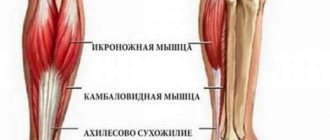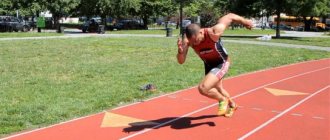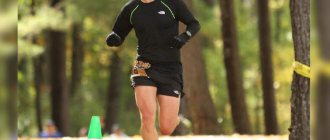Running is an integral part of the training process for athletes, an important component of exercise for fans of fitness and wellness, a necessary element for recovery from a number of illnesses, and simply a pleasant pastime for people accustomed to an active lifestyle. But in each of these cases, the person’s running speed is different. An athlete needs to reach its limit in order to show the best time in a race, have an advantage in the game or ensure a greater jump distance. More often than not, this type of training is a way to maintain physical fitness, and here records are not the goal. This is especially true for those who jog after illness.
Beginners, amateurs and athletes: sometimes a step faster
The average speed of movement when walking is 5 km in 1 hour. Athletes walkers walk much faster: 15 km/h for men and 14 for women. But they have a special technique that ordinary people do not use when walking. And even their jogging will be slower.
Naturally, with a shorter distance, the average running speed of a person, whether a beginner or a renowned sprinter, will be higher. If you take the classic 100-meter race, then an untrained beginner, giving his all, will run it in 14 - 16 seconds. Therefore, the average speed of a person when running along a distance: 25.7 – 22.5 km/h.
An unprepared amateur, having entered the track and field and given all his strength, will still not be able to show the result that his body is capable of. At the same time, he will also “pay” for his diligence with muscle pain. It’s fine if that’s the case, but it can also harm your heart! Only after training, which will ensure the necessary increase in muscle mass, adaptation of the cardiovascular and respiratory systems to the increased consumption of oxygen by muscle tissue, will the athlete noticeably improve his performance on the track within a month or two.
I have already described in detail what speed qualities and what results in running should be shown by athletes of different levels in the article “Running standards for schoolchildren, adults, military personnel, GTO standards.” So you can evaluate your level using the tables from the article.
Running speed of an ordinary person
The most ordinary healthy person, who has no contraindications to fast running, can show his speed data at a sprint distance of 100 meters.
After the race your legs will hurt, this is natural. Typically, the time it takes such an unprepared person to run a hundred meters ranges from 13 to 15 seconds.
Of course, people who are overweight, elderly, or have underlying health conditions are able to show significantly more modest results. And not everyone who walks normally can run.
A healthy person noticeably improves his performance after a month of training. Its time can be as long as 11.5-12 seconds (we are talking about an adult). Further, if you practice steadily and diligently, this time will gradually decrease by tenths, then by hundredths of a second. What if you become a new world record holder?
Average and maximum indicators
It should be understood that there is a concept of average speed when running and maximum. For track and field athletes, it differs at different parts of the distance. During the section of the path after the start, it is small: the athlete is just accelerating. And its peak is reached either closer to the finish (if it was a 60, 100 or 200-meter start), or towards the middle, if it’s a four-hundred-meter race (even a professional cannot run at the limit of all four hundred meters). At medium and long distances, the tactics of stayers can be different: powerful acceleration at the beginning, jerks along the way in the middle, a stormy finishing spurt, or all these elements combined.
The average speed of a person when jogging is 9 km/h. The body adapts perfectly to a measured, not too burdensome load and is able to maintain muscle work for a fairly long time.
How to run safer
Non-professional runners most often run at their natural cadence, which is different from their ideal cadence. However, some are more prone to injury, while others are less prone to injury. A pair of scientific papers examining the difference between the two were presented in June at the annual meeting of the American College of Sports Medicine.
In the first study, Erin Futrell, Adam Tenforde, Steve T. Jamison, Irene S. Davis. Relationships between natural cadence and vertical load rates in injured and healthy runners. 32 healthy and 93 injured runners took part. It showed that the average cadence of runners in both groups differed slightly: 164 and 161, respectively.
Scientists compared the load on the foot, and it was indeed higher in injured runners. However, no correlation of this parameter with the cadence of healthy and injured runners could be found.
In another study, Jacqueline Morgan, Robert L. Franco, Kate Harrison, Anson M. Blanks, Heather L. Caslin, DS Blaise Williams. Stride frequency and injury rates in recreational runners training for a half-marathon. 28 amateur runners participated who were preparing for the half marathon. In this case, there was a clear correlation between injury and cadence:
- 8 out of 12 runners with a cadence below 162 were injured - 67%;
- 5 out of 7 runners with a cadence of 163–168 were injured - 71%;
- Only 2 out of 9 runners with a cadence above 169 were injured - 22%.
It is worth noting that this study did not take into account the runners' initial training. During the study, the average cadence of all participants increased from 165 to 173 in preparation for the race. It is likely that runners with higher cadences were initially better prepared and therefore less prone to injury.
It turns out that the research data is mixed. Of course, this is not to say that cadence is not important for safe running. However, it makes no sense to rely only on this parameter: it is too early to name the ideal number.
At the same time, fewer contacts with the ground with longer steps also does not guarantee less load on the leg.
The most frisky on the track
If we talk about a person’s maximum speed in km/h, then we should look at the finish lists of track and field sprinters.
Fleet-footed Usain Bolt
The record belongs to the Jamaican athlete Usain Bolt , which he set during the international athletics competition in Berlin (2009), running 100 m in 9.58 seconds. In the last quarter of the distance, he was as fast as the wind: the instruments showed a figure of 44.7 (the average result for the entire hundred-meter race was 37.58 km/h). This is the fastest human running speed today.
At the Olympics in Brazil, he became the champion for the third time, but with a worse result - 9.81 s. The second fastest on the planet was the American Gatlin (9.89s), and the third was de Grasse from Canada (9.91s)
It is difficult to say when and who will be able to surpass Usain's running speed record. There is an opinion that people have already reached the maximum of their physical capabilities and further improvement is possible only with the use of doping. Looking at the progress since the first officially recorded best time in the 100m track and field event, it is 2.42 seconds in 113 years. The first record holder, Thomas Burke, ran the 100 meters in 12 seconds in 1896. But here it should be taken into account that the recording of time then was not as accurate as it is now.
The same Usain Bolt also has the best time on the planet in the 200 m athletics discipline - 19.19 seconds. Here his average over the entire distance was 37.52 km/h, which is even a little faster than at one hundred meters. This is explained by the fact that W. Bolt is a tall and large man; it takes distance and time to disperse such a mass.
When endurance is needed, not just speed
Longer distances allow you to reach maximum speed already in the middle of the journey, but it is impossible to maintain it until the finish line. Therefore, in 400-meter races the average speed is lower. Thus, the representative of South Africa, Wayde Van Niekerk , was 33.5 km/h, while he became the winner with world and Olympic records, his time was 43.03 s.
Maintaining a fast pace for 800 meters is even more difficult. At major athletics competitions, the discipline is already included in the short-medium category, although some consider it a long sprint. Probably to the tough African from Kenya, David Rushida , world record holder (1:40.91), it really doesn’t seem that long. He became an Olympic champion at two games in a row: in London and Rio de Janeiro. But if you look at the average speed a person develops when running 800 meters, it is significantly lower than that of sprinters: 28.5 km/h. The athletes run faster for the first half of the journey, then they slow down and, 150 meters before the finish, if they have any strength left, they speed up.
Not everyone can
Success in the marathon, on the contrary, lies in the rhythm of movements. It is impossible for an unprepared man or woman to run such a distance, since the body’s glycogen reserves (a source of energy) are running out, and the transition to using fat takes time. Hypoglycemia (low blood glucose) occurs, accompanied by loss of strength and other unpleasant sensations. In the worst case scenario, hypoglycemic coma and death may occur. Marathon runners train according to a special schedule, and the day before the race they traditionally eat a large portion of pasta to increase glycogen stores in the body. It will serve as a reservoir of energy for the muscles.
To date, the world championship belongs to Dennis Kimetto from Kenya, who ran the Berlin Marathon in 2014 in 2 hours, 2 minutes and 56 seconds. It turns out that he ran this distance at about 20.6 km/h. An ordinary person can only run that fast for a couple of laps around the stadium.
Marathon for lovers
Recently, the half marathon has been gaining popularity - running at speed along the highway for 21,000 m. Almost anyone can run this mileage. To do this you need to train for at least a month. Therefore, this type is very popular, although it is not an Olympic discipline. The fastest here are also Africans: Zersenay Tadese from Eritrea (time 58 minutes 23 seconds), who won in Portugal in 2010, and Samuel Wanjiru from Kenya (58 minutes 33 seconds), who won in 2007 in the Netherlands. They maintained a speed of movement over a distance of approximately 24 km/h.
Donovan Bailey, Canada
During the 1996 Summer Olympics in Atlanta, Canadian athlete Donovan Bailey set a world record. He covered the 100-meter distance in just 9.84 seconds. Thanks to this, he became the first Canadian in history to be included in the list of “fastest runners on the planet.” After finishing his sports career, he went into business and organized a charitable foundation. Its main goal is to help young athletes.
Tempo, what is it?
There is such a thing as running pace. It indicates how long it takes a person to cover a certain distance. This indicator is convenient to use when training, choosing how long it takes to cover a given distance in order to achieve the desired effect: lose weight, improve endurance, train the heart, etc. For example, the pace for training the heart muscle and fat oxidation can vary among people of different sizes and fitness from 5:30 to 7:00 minutes/km. For cross-country, a pace of around 5:00 min/km is suitable. But all indicators are individual, since people are all different.
Jerry Miculek
Athletics is not the only discipline where various speed records are set. Jerry Miculek has become one of the fastest shooters on the entire planet. In just 0.57 seconds, it can shoot 5 times at one playing card. In addition, he became the author of as many as five records for shooting from a revolver. Of course, this was facilitated by his passion for weapons and shooting, which Jerry has been teaching for quite a long time. During his life he tried almost all types of weapons.
It's no surprise that Jerry Miculek is a renowned expert gunsmith. This allows him to adjust and tune the revolvers as needed to ensure they operate as efficiently as possible.
Without exaggeration, we can say that every record is an indicator of willpower, character and endless dedication to exhausting training. Every athlete is worthy of respect, since not every person is capable of reaching such incredible heights in the world of sports.
Records among the world's best athletes
From all of the above, we can make a top list of athletes who were able to set a human running speed record. The top positions in it will be occupied by the following runners:
- Usain Bolt (Jamaica): 11-time world champion, unsurpassed by anyone so far in the 100 and 200 meters.
- Dennis Kimetto (Kenya): became the world's strongest at the Berlin Marathon on September 28, 2014.
- Paula Radcliffe (Great Britain): Named the world's best female athlete in 2002. She still holds the record set in 2003 at the London Marathon (2 hours, 15 minutes, 25 seconds).
Among the football players there are also many players who could compete with the best sprinters. The fastest of them is Antonio Valencia from Manchester United. This man's fastest running speed on the field is 35.1 km/h. Winger Gareth Bale of Real Madrid is distinguished by his ability to make quick bursts, accelerating in a matter of seconds. His teammate Cristiano Ronaldo can move around the field just as powerfully, with a recorded speed of 33.6 km/h.
Jesse Owens, USA
In 1932, a new record was set for the 100-meter dash – 10.2 seconds. Its owner was Jesse Owens from the USA. The record was set at the XI Olympic Games in Berlin, and it could not be broken for many years. By the way, then the athlete won four gold medals and was named the most outstanding athlete. Agree, a fascinating story of sporting achievements.









